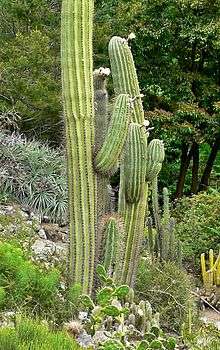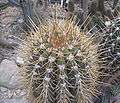Echinopsis terscheckii
Echinopsis terscheckii, commonly known as the cardon grande cactus or Argentine saguaro, is a large cactus native to South America and popular in cultivation.[1]
| Echinopsis terscheckii | |
|---|---|
 | |
| Scientific classification | |
| Kingdom: | Plantae |
| Clade: | Tracheophytes |
| Clade: | Angiosperms |
| Clade: | Eudicots |
| Order: | Caryophyllales |
| Family: | Cactaceae |
| Subfamily: | Cactoideae |
| Genus: | Echinopsis |
| Species: | E. terscheckii |
| Binomial name | |
| Echinopsis terscheckii (Parm.) Friedrich & G.D.Rowley | |
| Synonyms | |
| |
Description
It is a columnar, branching cactus that can grow over 7.6 metres (25 ft) tall.Its branches are about 25 cm (9.8 in) in diameter with 8 to 14 ribs. Branches are cylindrical, fleshy, light green. The branches are 10-20 cm in diameter, with 8-14 blunt ribs. It has large brownish areoles about 2.5 cm (0.98 in) apart with 8 to 15 yellowish spines, 8.3–10 cm (3.3–3.9 in) long, a central one, sometimes absent, and 8-15 radial. The nocturnal funnel-shaped white flowers can grow up to 15–20 cm (5.9–7.9 in) long and 13–15 cm (5.1–5.9 in) wide. Pericarp and flower tube with dense white or brown axillary hairs. The round or oblong blue fruits are about 1.3 cm (0.51 in) in diameter and contain black to brown, oval seeds approximately 0.76 mm (0.030 in) long.[2]
 Spines
Spines Flowers
Flowers Growth
Growth Buds
Buds.jpg) Crested plant
Crested plant
Native distribution
It is native to several provinces including Jujuy, Tucumán, La Rioja, San Juan, Catamarca and Salta provinces in northwestern Argentina, and is the eponymous cactus of Los Cardones National Park in Salta Province. Range continues to the western slopes of the Andes in Peru, Bolivia department of Tarija, and Ecuador. It is found growing on dry slopes of the Andean foothills at altitudes of 500 to 1500 meters.
Taxonomy
This species was first description as Cereus terscheckii by Ludwig Georg Karl Pfeiffer was published in 1837. Heimo Friedrich and Gordon Douglas Rowley placed the species in the genus Echinopsis in 1974[2].
Alkaloids
Echinopsis terscheckii contains > 0.005-0.025% mescaline[3] in fresh cactus and 0.01%-2.375%[4] mescaline in dry weight.
References
- "Cardon Grande (Echinopsis terscheckii)". Desert-tropicals.com. Retrieved 14 January 2015.
- Rowley, Gordon (1978). Reunion of the Genus Echinopsis. The Illustrated Encyclopedia of Succulents. New York: Crown Publishing. ISBN 978-0-517-53309-3.
- "Partial List of Alkaloids in Trichocereus Cacti". Thennok.org. Retrieved 22 December 2017.
- Forbidden Fruit Archives Archived 2005-11-28 at the Wayback Machine
